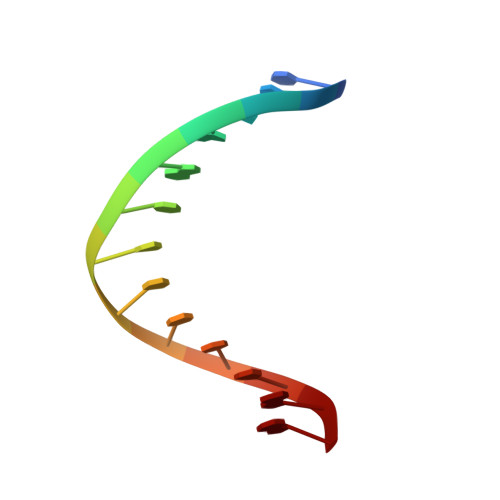DNA oligonucleotides with A, T, G or C opposite an abasic site: structure and dynamics.
Chen, J., Dupradeau, F.Y., Case, D.A., Turner, C.J., Stubbe, J.(2008) Nucleic Acids Res 36: 253-262
- PubMed: 18025040
- DOI: https://doi.org/10.1093/nar/gkm622
- Primary Citation of Related Structures:
2O7W, 2O7X, 2O7Y, 2O7Z, 2O80, 2O82 - PubMed Abstract:
Abasic sites are common DNA lesions resulting from spontaneous depurination and excision of damaged nucleobases by DNA repair enzymes. However, the influence of the local sequence context on the structure of the abasic site and ultimately, its recognition and repair, remains elusive. In the present study, duplex DNAs with three different bases (G, C or T) opposite an abasic site have been synthesized in the same sequence context (5'-CCA AAG6 XA8C CGG G-3', where X denotes the abasic site) and characterized by 2D NMR spectroscopy. Studies on a duplex DNA with an A opposite the abasic site in the same sequence has recently been reported [Chen,J., Dupradeau,F.-Y., Case,D.A., Turner,C.J. and Stubbe,J. (2007) Nuclear magnetic resonance structural studies and molecular modeling of duplex DNA containing normal and 4'-oxidized abasic sites. Biochemistry, 46, 3096-3107]. Molecular modeling based on NMR-derived distance and dihedral angle restraints and molecular dynamics calculations have been applied to determine structural models and conformational flexibility of each duplex. The results indicate that all four duplexes adopt an overall B-form conformation with each unpaired base stacked between adjacent bases intrahelically. The conformation around the abasic site is more perturbed when the base opposite to the lesion is a pyrimidine (C or T) than a purine (G or A). In both the former cases, the neighboring base pairs (G6-C21 and A8-T19) are closer to each other than those in B-form DNA. Molecular dynamics simulations reveal that transient H-bond interactions between the unpaired pyrimidine (C20 or T20) and the base 3' to the abasic site play an important role in perturbing the local conformation. These results provide structural insight into the dynamics of abasic sites that are intrinsically modulated by the bases opposite the abasic site.
Organizational Affiliation:
Department of Chemistry Massachusetts Institute of Technology, 77 Massachusetts Avenue, Cambridge, MA 02139, USA.















